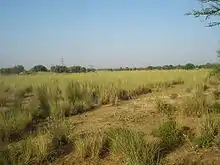Saccharum munja
Saccharum munja, known as munja (Hindi: मुंज) is a grass found in arid areas and along river banks in India. it belongs to the family Gramineae. It grows up to 2 meters (7 feet) in height. Its white flowers are of ornamental value.
| Saccharum munja | |
|---|---|
.JPG.webp) | |
| Scientific classification | |
| Kingdom: | |
| (unranked): | |
| (unranked): | Monocots |
| (unranked): | |
| Order: | |
| Family: | |
| Genus: | |
| Species: | S. munja |
| Binomial name | |
| Saccharum munja | |
Uses

Saccharum munja is used as a raw material for thatching roofs. It is used for making baskets. The plant has medicinal value.[1] Its fibre is used for making ropes. Saccharum munja, a perennial wild grass, is one of the ecologically successful native colonizer of abandoned mines. It forms pure patches on rocky habitats with skeletal soils. It forms extensive root network that binds the soil/pebbles and forms tall thick clumps with high biomass tufts. It is used by low income locals for making ropes, hand fans, baskets, brooms, mat, hut and shields for crop protection. Saccharum munja is a choice species for vegetation and stabilization of erosion-prone rugged slopes and their conversion into biologically productive sites of high socio-economic values. Sharma M, Rau N, Mishra V, Sharma RS (2005) Species. 43:22
References
- L R Burdak (1982): Recent advances in desert afforestation, Dehradun, p. 66
- Sandeep, Rahar; Nagpal Navneet; Swami Gaurav; Arora Manisha; Bansal Suraj; Bansal Suraj; Singla Shwali; Singla Shwali; Singla Shwali (2010). "Medicinal Aspects of Saccharum munja". Research Journal of Pharmacy and Technology. 3 (3): 636–639.